coolant KIA RIO HATCHBACK 2016 Owner's Manual
[x] Cancel search | Manufacturer: KIA, Model Year: 2016, Model line: RIO HATCHBACK, Model: KIA RIO HATCHBACK 2016Pages: 477, PDF Size: 13.46 MB
Page 388 of 477
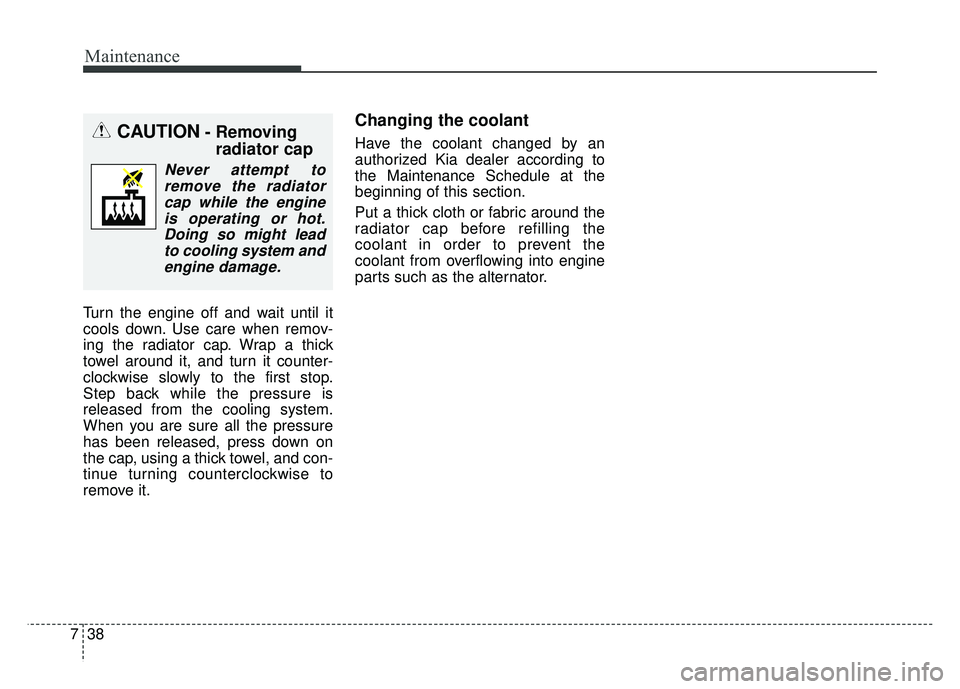
Maintenance
38
7
Turn the engine off and wait until it
cools down. Use care when remov-
ing the radiator cap. Wrap a thick
towel around it, and turn it counter-
clockwise slowly to the first stop.
Step back while the pressure is
released from the cooling system.
When you are sure all the pressure
has been released, press down on
the cap, using a thick towel, and con-
tinue turning counterclockwise to
remove it.
Changing the coolant
Have the coolant changed by an
authorized Kia dealer according to
the Maintenance Schedule at the
beginning of this section.
Put a thick cloth or fabric around the
radiator cap before refilling the
coolant in order to prevent the
coolant from overflowing into engine
parts such as the alternator.CAUTION- Removing
radiator cap
Never attempt to
remove the radiator cap while the engineis operating or hot.Doing so might leadto cooling system andengine damage.
Page 410 of 477
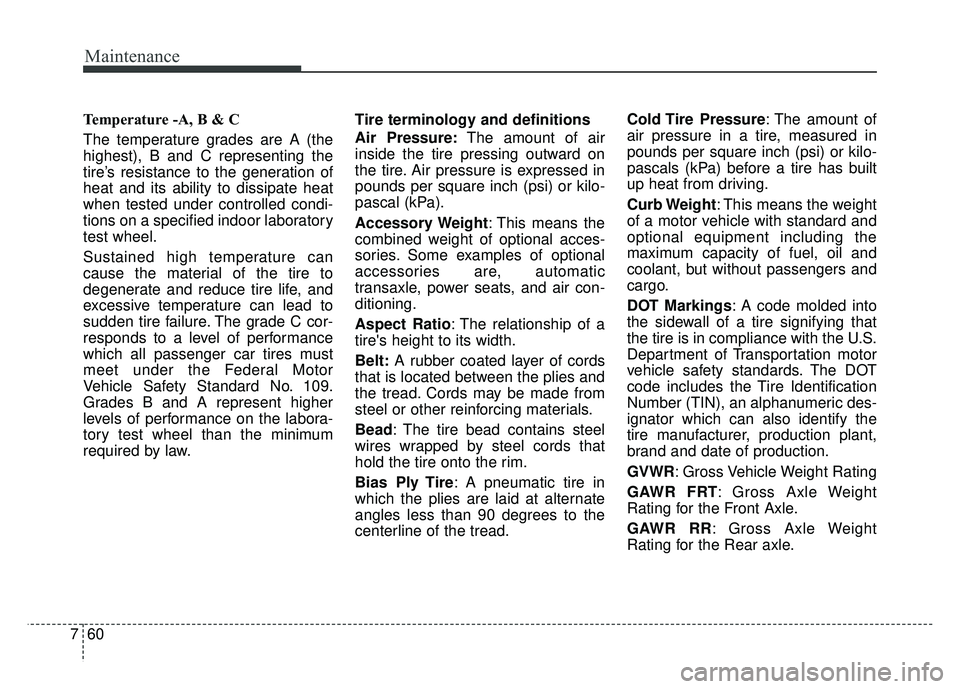
Maintenance
60
7
Temperature -A, B & C
The temperature grades are A (the
highest), B and C representing the
tire’s resistance to the generation of
heat and its ability to dissipate heat
when tested under controlled condi-
tions on a specified indoor laboratory
test wheel.
Sustained high temperature can
cause the material of the tire to
degenerate and reduce tire life, and
excessive temperature can lead to
sudden tire failure. The grade C cor-
responds to a level of performance
which all passenger car tires must
meet under the Federal Motor
Vehicle Safety Standard No. 109.
Grades B and A represent higher
levels of performance on the labora-
tory test wheel than the minimum
required by law. Tire terminology and definitions
Air Pressure:
The amount of air
inside the tire pressing outward on
the tire. Air pressure is expressed in
pounds per square inch (psi) or kilo-
pascal (kPa).
Accessory Weight : This means the
combined weight of optional acces-
sories. Some examples of optional
accessories are, automatic
transaxle, power seats, and air con-
ditioning.
Aspect Ratio : The relationship of a
tire's height to its width.
Belt: A rubber coated layer of cords
that is located between the plies and
the tread. Cords may be made from
steel or other reinforcing materials.
Bead: The tire bead contains steel
wires wrapped by steel cords that
hold the tire onto the rim.
Bias Ply Tire : A pneumatic tire in
which the plies are laid at alternate
angles less than 90 degrees to the
centerline of the tread. Cold Tire Pressure: The amount of
air pressure in a tire, measured in
pounds per square inch (psi) or kilo-
pascals (kPa) before a tire has built
up heat from driving.
Curb Weight: This means the weight
of a motor vehicle with standard and
optional equipment including the
maximum capacity of fuel, oil and
coolant, but without passengers and
cargo.
DOT Markings: A code molded into
the sidewall of a tire signifying that
the tire is in compliance with the U.S.
Department of Transportation motor
vehicle safety standards. The DOT
code includes the Tire Identification
Number (TIN), an alphanumeric des-
ignator which can also identify the
tire manufacturer, production plant,
brand and date of production.
GVWR: Gross Vehicle Weight Rating
GAWR FRT: Gross Axle Weight
Rating for the Front Axle.
GAWR RR: Gross Axle Weight
Rating for the Rear axle.
Page 449 of 477

799
Maintenance
Canister
Fuel vapors generated inside the fuel
tank are absorbed and stored in the
onboard canister. When the engine is
running, the fuel vapors absorbed in
the canister are drawn into the surge
tank through the purge control sole-
noid valve.
Purge Control Solenoid Valve(PCSV)
The purge control solenoid valve is
controlled by the Engine Control
Module (ECM); when the engine
coolant temperature is low during
idling, the PCSV closes so that evap-
orated fuel is not taken into the
engine. After the engine warms up
during ordinary driving, the PCSV
opens to introduce evaporated fuel to
the engine.
3. Exhaust emission control system
The Exhaust Emission Control
System is a highly effective system
which controls exhaust emissions
while maintaining good vehicle per-
formance.
Vehicle modifications
This vehicle should not be modified.
Modification of your vehicle could
affect its performance, safety or
durability and may even violate gov-
ernmental safety and emissions reg-
ulations.
In addition, damage or performance
problems resulting from any modifi-
cation may not be covered under
warranty.
If you use unauthorized electronic
devices, it may cause the vehicle to
operate abnormally, wire damage,
battery discharge and fire. For your
safety, do not use unauthorized
electronic devices.
Engine exhaust gas precautions
(carbon monoxide)
Carbon monoxide can be present with other exhaust fumes.
Therefore, if you smell exhaust
fumes of any kind inside your vehi-
cle, have it inspected and repaired
immediately. If you ever suspect
exhaust fumes are coming into
your vehicle, drive it only with all
the windows fully open. Have your
vehicle checked and repaired
immediately.
WARNING - Exhaust
Engine exhaust gases contain
carbon monoxide (CO). Though
colorless and odorless, it is
dangerous and could be lethal if
inhaled. Follow the instructions
on this page to avoid CO poi-
soning.
Page 458 of 477
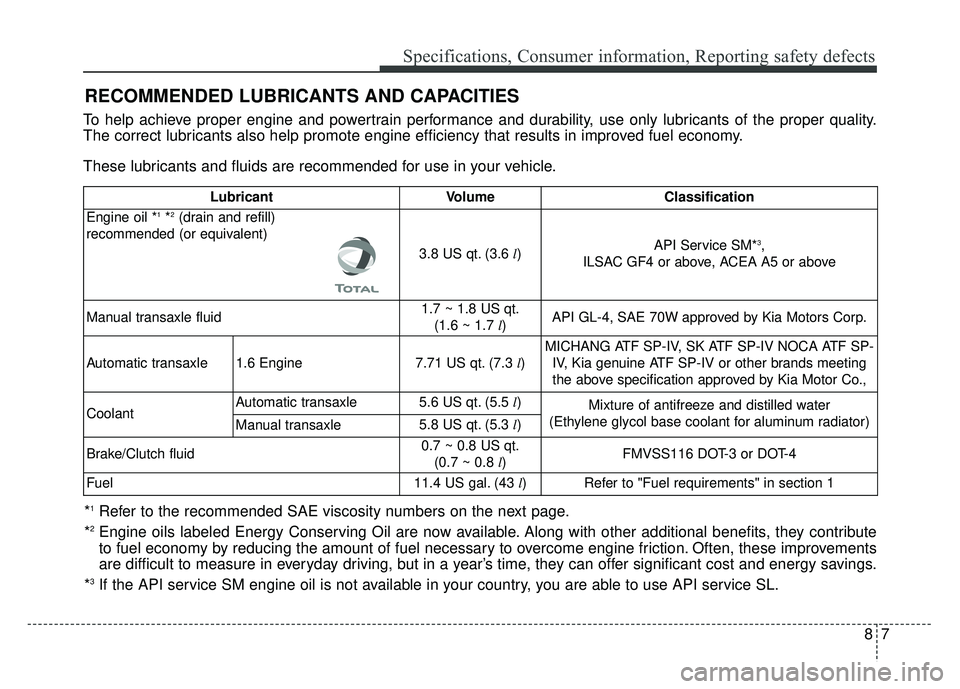
87
Specifications, Consumer information, Reporting safety defects
RECOMMENDED LUBRICANTS AND CAPACITIES
To help achieve proper engine and powertrain performance and durability, use only lubricants of the proper quality.
The correct lubricants also help promote engine efficiency that results in improved fuel economy.
These lubricants and fluids are recommended for use in your vehicle.
*1Refer to the recommended SAE viscosity numbers on the next page.
*2Engine oils labeled Energy Conserving Oil are now available. Along with other additional benefits, they contribute
to fuel economy by reducing the amount of fuel necessary to overcome engine friction. Often, these improvements
are difficult to measure in everyday driving, but in a year’s time, they can offer significant cost and energy savings.
*
3If the API service SM engine oil is not available in your country, you are able to use API service SL.
Lubricant Volume Classification
Engine oil *
1*2(drain and refill)
recommended (or equivalent)
3.8 US qt. (3.6 l) API Service SM*
3,
ILSAC GF4 or above, ACEA A5 or above
Manual transaxle fluid 1.7 ~ 1.8 US qt.
(1.6 ~ 1.7 l) API GL-4, SAE 70W approved by Kia Motors Corp.
Automatic transaxle 1.6 Engine 7.71 US qt. (7.3
l)MICHANG ATF SP-IV, SK ATF SP-IV NOCA ATF SP-
IV, Kia genuine ATF SP-IV or other brands meetingthe above specification approved by Kia Motor Co.,
Coolant Automatic transaxle
5.6 US qt. (5.5 l)
Mixture of antifreeze and distilled water
(Ethylene glycol base coolant for aluminum radiator)
Manual transaxle 5.8 US qt. (5.3
l)
Brake/Clutch fluid 0.7 ~ 0.8 US qt.
(0.7 ~ 0.8 l) FMVSS116 DOT-3 or DOT-4
Fuel 11.4 US gal. (43 l)
Refer to "Fuel requirements" in section 1
Page 469 of 477
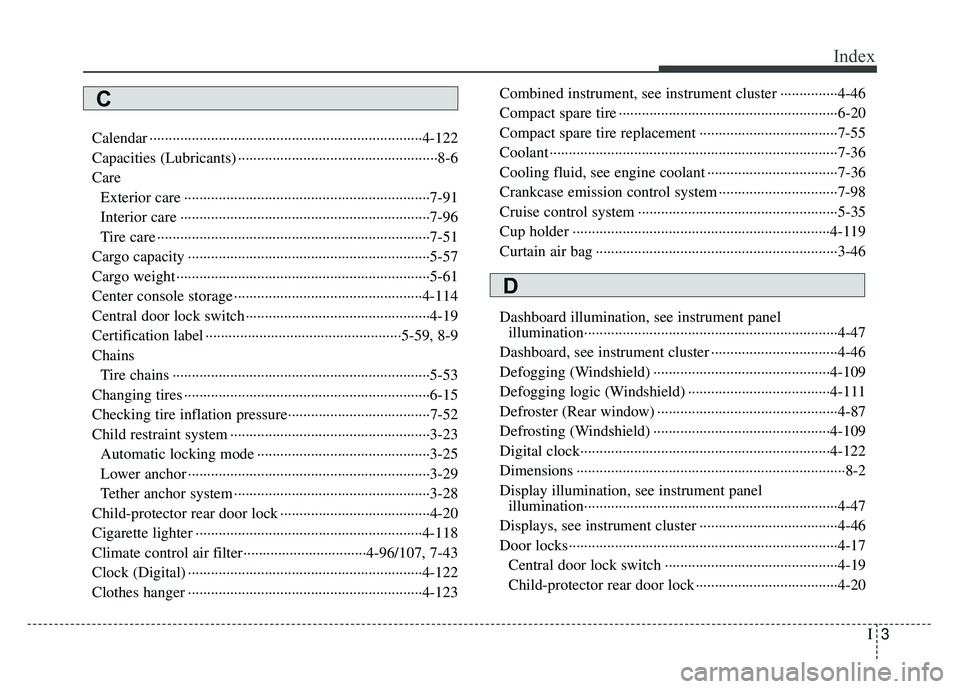
I3
Index
Calendar ··················\
··················\
··················\
·················4-12\
2
Capacities (Lubricants) ··················\
··················\
················8-6
CareExterior care ··················\
··················\
··················\
··········7-91
Interior care ··················\
··················\
··················\
···········7-96
Tire care ··················\
··················\
··················\
·················7-51\
Cargo capacity ··················\
··················\
··················\
·········5-57
Cargo weight ··················\
··················\
··················\
············5-61
Center console storage ··················\
··················\
·············4-114
Central door lock switch··················\
··················\
············4-19
Certification label ··················\
··················\
···············5-59, 8-9
Chains Tire chains ··················\
··················\
··················\
·············5-53
Changing tires ··················\
··················\
··················\
··········6-15
Checking tire inflation pressure··················\
··················\
·7-52
Child restraint system ··················\
··················\
················3-23 Automatic locking mode ··················\
··················\
·········3-25
Lower anchor ··················\
··················\
··················\
·········3-29
Tether anchor system ··················\
··················\
···············3-28
Child-protector rear door lock ··················\
··················\
···4-20
Cigarette lighter ··················\
··················\
··················\
·····4-118
Climate control air filter··················\
··············4-96/107, 7-43
Clock (Digital) ··················\
··················\
··················\
·······4-122
Clothes hanger ··················\
··················\
··················\
·······4-123 Combined instrument, see instrument cluster ···············4-46
Compact spare tire ··················\
··················\
··················\
···6-20
Compact spare tire replacement ··················\
··················\
7-55
Coolant ··················\
··················\
··················\
··················\
···7-36
Cooling fluid, see engine coolant ··················\
················7-36
Crankcase emission control system ··················\
·············7-98
Cruise control system ··················\
··················\
················5-35
Cup holder ··················\
··················\
··················\
·············4-119
Curtain air bag ··················\
··················\
··················\
·········3-46
Dashboard illumination, see instrument panel
illumination··················\
··················\
··················\
············4-47
Dashboard, see instrument cluster ··················\
···············4-46
Defogging (Windshield) ··················\
··················\
··········4-109
Defogging logic (Windshield) ··················\
··················\
·4-111
Defroster (Rear window) ··················\
··················\
···········4-87
Defrosting (Windshield) ··················\
··················\
··········4-109
Digital clock··················\
··················\
··················\
···········4-122
Dimensions ··················\
··················\
··················\
················8-2
Display illumination, see instrument panel illumination··················\
··················\
··················\
············4-47
Displays, see instrument cluster ··················\
··················\
4-46
Door locks··················\
··················\
··················\
················4-17 Central door lock switch ··················\
··················\
·········4-19
Child-protector rear door lock ··················\
··················\
·4-20
D
C
Page 470 of 477
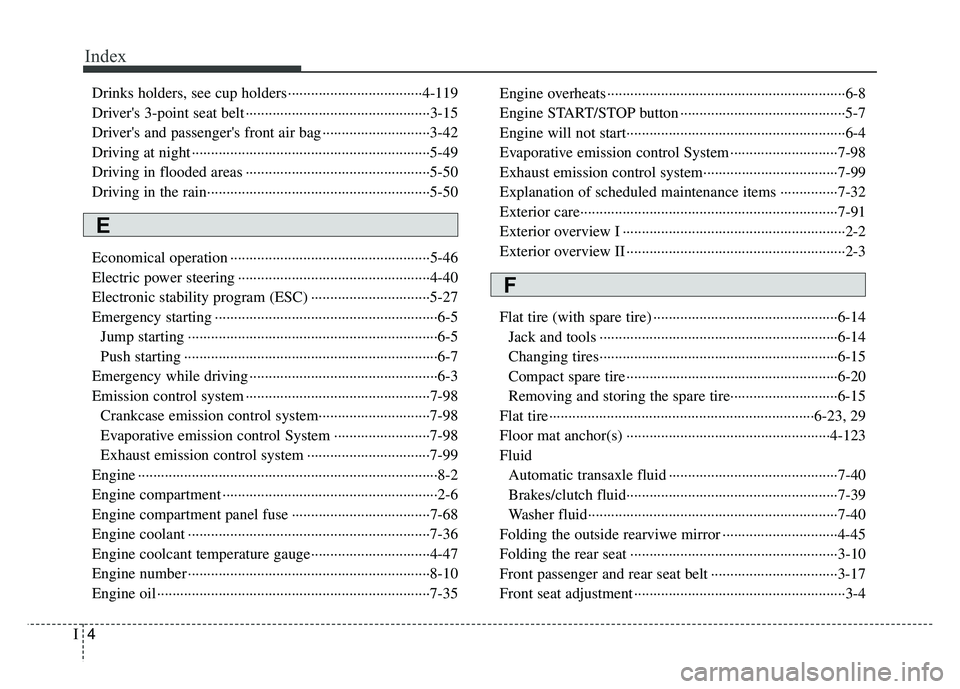
Index
4I
Drinks holders, see cup holders··················\
·················4-11\
9
Driver's 3-point seat belt ··················\
··················\
············3-15
Driver's and passenger's front air bag ··················\
··········3-42
Driving at night ··················\
··················\
··················\
········5-49
Driving in flooded areas ··················\
··················\
············5-50
Driving in the rain··················\
··················\
··················\
····5-50
Economical operation ··················\
··················\
················5-46
Electric power steering ··················\
··················\
··············4-40
Electronic stability program (ESC) ··················\
·············5-27
Emergency starting ··················\
··················\
··················\
····6-5Jump starting ··················\
··················\
··················\
···········6-5
Push starting ··················\
··················\
··················\
············6-7
Emergency while driving ··················\
··················\
·············6-3
Emission control system ··················\
··················\
············7-98 Crankcase emission control system··················\
···········7-98
Evaporative emission control System ··················\
·······7-98
Exhaust emission control system ··················\
··············7-99
Engine ··················\
··················\
··················\
··················\
······8-2
Engine compartment ··················\
··················\
··················\
··2-6
Engine compartment panel fuse ··················\
··················\
7-68
Engine coolant ··················\
··················\
··················\
·········7-36
Engine coolcant temperature gauge··················\
·············4-47
Engine number ··················\
··················\
··················\
·········8-10
Engine oil ··················\
··················\
··················\
·················7-35\
Engine overheats ··················\
··················\
··················\
········6-8
Engine START/STOP button ··················\
··················\
·······5-7
Engine will not start··················\
··················\
··················\
···6-4
Evaporative emission control System ··················\
··········7-98
Exhaust emission control system··················\
·················7-99\
Explanation of scheduled maintenance items ···············7-32
Exterior care··················\
··················\
··················\
·············7-91
Exterior overview I ··················\
··················\
··················\
····2-2
Exterior overview II ··················\
··················\
··················\
···2-3
Flat tire (with spare tire) ··················\
··················\
············6-14
Jack and tools ··················\
··················\
··················\
········6-14
Changing tires··················\
··················\
··················\
········6-15
Compact spare tire ··················\
··················\
··················\
·6-20
Removing and storing the spare tire···········\
·················6-15\
Flat tire··················\
··················\
··················\
···············6-23, 29
Floor mat anchor(s) ··················\
··················\
·················4-12\
3
Fluid Automatic transaxle fluid ··················\
··················\
········7-40
Brakes/clutch fluid··················\
··················\
··················\
·7-39
Washer fluid··················\
··················\
··················\
···········7-40
Folding the outside rearviwe mirror ··················\
············4-45
Folding the rear seat ··················\
··················\
··················\
3-10
Front passenger and rear seat belt ··················\
···············3-17
Front seat adjustment ··················\
··················\
··················\
·3-4
F
E
Page 471 of 477
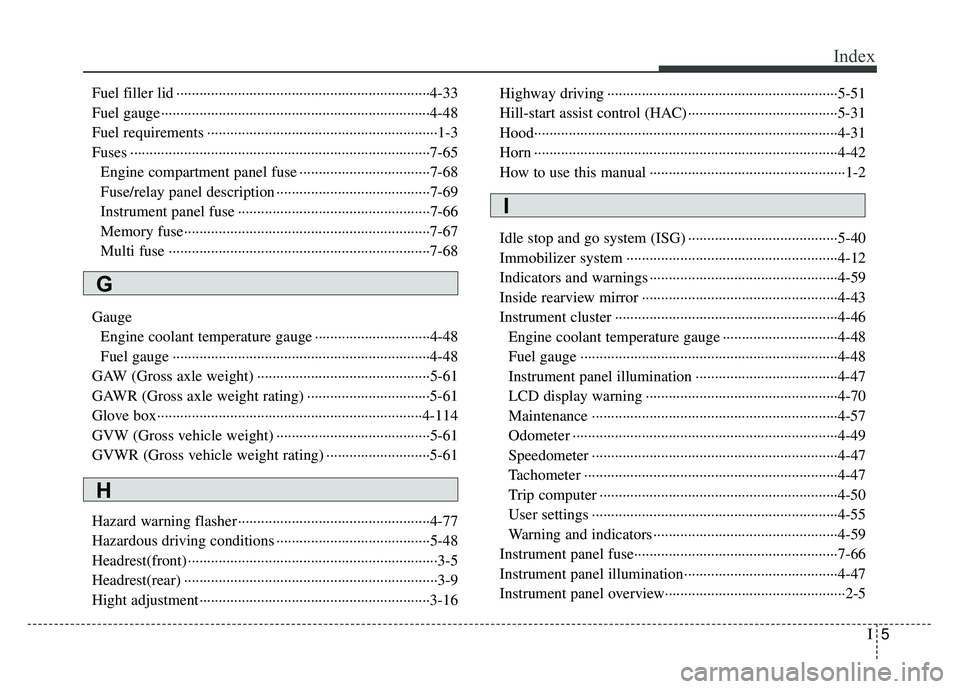
I5
Index
Fuel filler lid ··················\
··················\
··················\
············4-33
Fuel gauge··················\
··················\
··················\
················4-48
Fuel requirements ··················\
··················\
··················\
······1-3
Fuses ··················\
··················\
··················\
··················\
······7-65Engine compartment panel fuse ··················\
················7-68
Fuse/relay panel description ··················\
··················\
····7-69
Instrument panel fuse ··················\
··················\
··············7-66
Memory fuse··················\
··················\
··················\
··········7-67
Multi fuse ··················\
··················\
··················\
··············7-68
Gauge Engine coolant temperature gauge ··················\
············4-48
Fuel gauge ··················\
··················\
··················\
·············4-48
GAW (Gross axle weight) ··················\
··················\
·········5-61
GAWR (Gross axle weight rating) ··················\
··············5-61
Glove box··················\
··················\
··················\
···············4-114
GVW (Gross vehicle weight) ··················\
··················\
····5-61
GVWR (Gross vehicle weight rating) ··················\
·········5-61
Hazard warning flasher ··················\
··················\
··············4-77
Hazardous driving conditions ··················\
··················\
····5-48
Headrest(front) ··················\
··················\
··················\
···········3-5
Headrest(rear) ··················\
··················\
··················\
············3-9
Hight adjustment··················\
··················\
··················\
······3-16 Highway driving ··················\
··················\
··················\
······5-51
Hill-start assist control (HAC) ··················\
··················\
···5-31
Hood··················\
··················\
··················\
··················\
·······4-31
Horn ··················\
··················\
··················\
··················\
·······4-42
How to use this manual ··················\
··················\
···············1-2
Idle stop and go system (ISG) ··················\
··················\
···5-40
Immobilizer system ··················\
··················\
··················\
·4-12
Indicators and warnings ··················\
··················\
·············4-59
Inside rearview mirror ··················\
··················\
···············4-43
Instrument cluster ··················\
··················\
··················\
····4-46
Engine coolant temperature gauge ··················\
············4-48
Fuel gauge ··················\
··················\
··················\
·············4-48
Instrument panel illumination ··················\
··················\
·4-47
LCD display warning ··················\
··················\
··············4-70
Maintenance ··················\
··················\
··················\
··········4-57
Odometer ··················\
··················\
··················\
···············4-49
Speedometer ··················\
··················\
··················\
··········4-47
Tachometer ··················\
··················\
··················\
············4-47
Trip computer ··················\
··················\
··················\
········4-50
User settings ··················\
··················\
··················\
··········4-55
Warning and indicators ··················\
··················\
············4-59
Instrument panel fuse··················\
··················\
·················7-66\
Instrument panel illumination··················\
··················\
····4-47
Instrument panel overview··················\
··················\
···········2-5
G
H
I